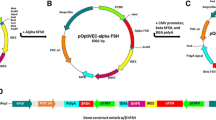Summary
In order to assess the impact of mRNA degradation on steady state levels of follicle-stimulating hormone receptor (FSHR) mRNA and on regulation of FSHR gene expression, the stability and half-life of FSHR mRNA were determined in transfected cells expressing recombinant FSHR. Time-dependent changes in FSHR mRNA content were determined by nuclease protection-solution hybridization assay (NPA) or by qualitative reverse transcription-competitive polymerase chain reaction (RT-PCR) in cultured hFSHR-YI cells, cell lines stably transfected with a human FSHR cD-NA. FSHR mRNA content remained constant during 8 h control incubations of hFSHR-YI cells (NPA, 2. 9±0. 3 μg/mg RNA; RT-PCR, 2. 7±0. 3 μg/mg RNA). Actinomycin D (ActD, 5 μg/ ml) inhibited mRNA synthesis, as assessed by incorporation of [3H]uridine into total RNA, by 90 % within 1 h in hFSHR-Y1 cells. No effect of ActD on cellular morphology or viability was observed. ActD caused a time-dependent decrease in FSHR mRNA content in hFSHR-Y1 cell lines with a lag time of 1 h. There were no significant differences in the rate of FSHR mRNA degradation between the two methods of mRNA quantification. The half-life of hFSHR mRNA was 3. 6±0. 2 h by NPA and 3. l±0. 1 h by RT-PCR. The results indicated that degradation of mRNA was an important process in maintenance of steady state expression of the FSHR gene in cells stably expressing recombinant receptor.
Similar content being viewed by others
References
Nimrod A, Erickson G F, Ryan K J. A specific FSH receptor in rat cells: Properties of bindingin vitro. Endocrinology, 1976, 98: 56
Gromoll J, Dankbar B, Sharma R Set al. Molecular cloning of the testicular follicle stimulating hormone receptor of the non human primate macaca fascicularis and identification multiple transcripts in the testis. Biochem Biophys Res Commun, 1993, 196: 1066
Ross J. mRNA stability in mammalian cells. Microbiol Rev, 1995, 59: 423
Kindy M S, Sonenshein G E. Regulation of oncogene expression in cultured aortic smooth cells. Post-transcriptional control of c-myc mENA. J Biol Chem, 1986, 261: 12865
Sachs A B. Messenger RNA degradation in eukaryotes. Cell, 1993, 74: 413
Diviacco S, Norio P, Zentilin Let al. A novel procedure for quantitative polymerase chain reaction by coamplification of competitive templates. Gene, 1992, 15: 313
Durnam D M, Palmiter R D. A Practical approach for quantitating specific mRNAs by solution hybridization. Anal Biochem, 1983, 131: 385
Gromoll J, Pekel E, Nieschlag E. The structure and organization of the human follicle-stimulating hormone receptor (FSHR) gene. Genomics, 1996, 35: 308
Attardi B, Winters SJ. Decay of follicle-stimulating hormone-(messenger RNA in the presence of transcriptional inhibitors and/or inhibin, activin, or follistatin. Mol Endocrinol, 1993, 7: 668
Dankbar B, Sohn M, Nieschlag Eet al. Quantification of androgen receptor and follicle-stimulating hormone receptor mRNA levels in human and monkey testis by a ribonuclease protection assay. Int J Androl, 1995, 18: 88
Chuzel F, Schteingart H, Vigier Met al. Transcriptional and post-transcriptional regulation of luteotropin/ chorionic gonadotropin receptor by the agonist in Leydig cells. Eur J Biochem, 1995, 220: 316
Shi H, Segaloff D L. A role for increased lutropin/choriogonadotropin receptor (LHR) gene transcription in the follitropin-stimulated induction of the LHR in granulosa cells. Mol Endocrinol, 1995, 9: 734
Collins S, Bouvier M, Bolanowski M Aet al. cAMP stimulates transcription of the (2-adrenergic receptor gene in response to short-term agonist exposure. Proc Natl Acad Sci USA, 1989, 86: 4853
Tano M, Minegishi T, Nakmura Ket al. Transcriptional and post-transcriptional regulation of FSH receptor in rat granulosa cells by cAMP and activin. J Endocrinol, 1997, 153: 465
Author information
Authors and Affiliations
Additional information
This work was supported by Hubei Family Planning Lommision Foundation and Hubei Science and Technology Department Foundation.
Rights and permissions
About this article
Cite this article
Changhong, Z., Hong, T. Stability of human follicle-stimulating hormone receptor mRNA in stably transfected cells. Current Medical Science 21, 8–12 (2001). https://doi.org/10.1007/BF02888024
Received:
Published:
Issue Date:
DOI: https://doi.org/10.1007/BF02888024




